Based on postmortem brain analysis, aggregation of α-synuclein in the brain is considered responsible for the onset and progression of Parkinson's disease and Lewy body dementia. However, what actually happens in the brain in vivo was yet to be observed. A research group led by Senior Researcher Hironobu Endo of the Advanced Neuroimaging Center at the Institute for Quantum Medical Science and Researcher Maiko Ono at Institute for Quantum Life Science of the National Institutes for Quantum Science and Technology (QST), visualized α-synuclein deposition lesions in the brains of patients with Parkinson's disease and Lewy body dementia for the first time in the world. They found that the amount of α-synuclein depositions is associated with the severity of motor symptoms. The findings are expected to contribute to the elucidation of pathophysiology and the development of therapeutic agents and were published in the online edition of Neuron.

Provided by QST
Previously, the research group successfully imaged α-synuclein in multiple system atrophy. However, the low amount of α-synuclein seen in Parkinson's disease (about a hundredth of amyloid-β in Alzheimer's disease) and the presence of intracellular α-synuclein hampered the development of positron emission tomography (PET) ligands.
In this study, they succeeded in visualizing α-synuclein lesions by modifying the PET ligand previously developed to detect tau protein. The key point was the conversion of a part of the linker portion of the ligand from a double bond to a triple bond.
Ono commented, "This substitution may have caused part of the ligand to twist and fitted the β-sheet structure of α-synuclein, making the resulting ligand capable of binding to α-synuclein very well but to amyloid-β and other substances not very well." In fact, the PET ligand was administered to patients with Parkinson's disease and Lewy body dementia. The ligand deposited in a larger amount when more α-synuclein deposited in lesions in the midbrain and motor dysfunction was more severe, showing a correlation between motor function and the amount of deposition.
Journal Information
Publication: Neuron
Title: Imaging α-synuclein pathologies in animal models and patients with Parkinson's and related diseases
DOI: 10.1016/j.neuron.2024.05.006
This article has been translated by JST with permission from The Science News Ltd. (https://sci-news.co.jp/). Unauthorized reproduction of the article and photographs is prohibited.




